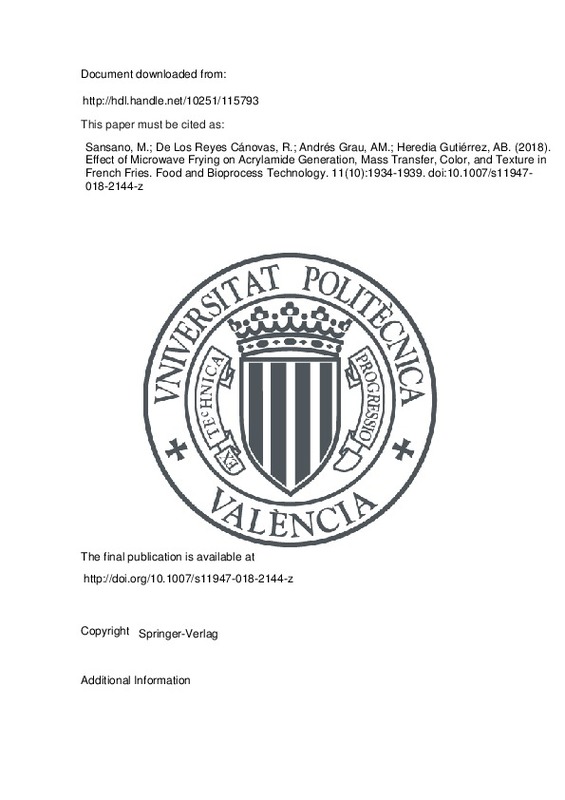AACC. (1995). Approved methods of the American association of cereal chemists (9th ed.). St. Paul: The Association.
Adedeji, A. A., Ngadi, M. O., & Raghavan, G. S. V. (2009). Kinetics of mass transfer in microwave precooked and deep-fat fried chicken nuggets. Journal of Food Engineering, 91(1), 146–153.
Ahrné, L., Andersson, C.-G., Floberg, P., Rosén, J., & Lingnert, H. (2007). Effect of crust temperature and water content on acrylamide formation during baking of white bread: steam and falling temperature baking. LWT-Food Science and Technology, 40(10), 1708–1715.
[+]
AACC. (1995). Approved methods of the American association of cereal chemists (9th ed.). St. Paul: The Association.
Adedeji, A. A., Ngadi, M. O., & Raghavan, G. S. V. (2009). Kinetics of mass transfer in microwave precooked and deep-fat fried chicken nuggets. Journal of Food Engineering, 91(1), 146–153.
Ahrné, L., Andersson, C.-G., Floberg, P., Rosén, J., & Lingnert, H. (2007). Effect of crust temperature and water content on acrylamide formation during baking of white bread: steam and falling temperature baking. LWT-Food Science and Technology, 40(10), 1708–1715.
Amrein, T. M., Limacher, A., Conde-Petit, B., Amadò, R., & Escher, F. (2006). Influence of thermal processing conditions on acrylamide generation and Browning in a potato model system. Journal of Agricultural and Food Chemistry, 54(16), 5910–5916.
Andrés, A., Arguelles, Á., Castelló, M. L., & Heredia, A. (2013). Mass transfer and volume changes in French fries during air frying. Food and Bioprocess Technology, 6(8), 1917–1924.
Barutcu, I., Sahin, S., & Sumnu, G. (2009). Acrylamide formation in different batter formulations during microwave frying. LWT - Food Science and Technology, 42(1), 17–22.
Belgin Erdoǧdu, S., Palazoǧlu, T. K., Gökmen, V., Şenyuva, H. Z., & Ekiz, H. İ. (2007). Reduction of acrylamide formation in French fries by microwave pre-cooking of potato strips. Journal of the Science of Food and Agriculture, 87(1), 133–137.
Biedermann, M., Noti, A., Biedermann-Brem, S., Mozzetti, V., & GROB, K. (2002). Experiments on acrylamide formation and possibilities to decrease the potential of acrylamide formation in potatoes. Mitteilungen aus Lebensmitteluntersuchung und Hygiene, 93(6), 668–687.
Bråthen, E., & Knutsen, S. H. (2005). Effect of temperature and time on the formation of acrylamide in starch-based and cereal model systems, flat breads and bread. Food Chemistry, 92(4), 693–700.
Buffler, C. R. (1993). Microwave cooking and processing: Engineering fundamentals for the food scientist. (A. Books, Ed.). New York: Van Nostrand Reinhold.
Datta, A. K. (1990). Heat and mass transfer in the microwave processing of food. Chemical Engineering Progress, 86(6), 47–53.
Datta, A. K. (2001). Handbook of microwave technology for food application. CRC Press.
De los Reyes, R., Heredia, A., Fito, P., De los Reyes, E., & Andrés, A. (2007). Dielectric spectroscopy of osmotic solutions and osmotically dehydrated tomato products. Journal of Food Engineering, 80(4), 1218–1225. 2.
Granda, C., & Moreira, R. G. (2005). Kinetics of acrylamide formation during traditional and vacuum frying of potato chips. Journal of Food Process Engineering, 28(5), 478–493.
Lizhi, H., Toyoda, K., & Ihara, I. (2008). Dielectric properties of edible oils and fatty acids as a function of frequency, temperature, moisture and composition. Journal of Food Engineering, 88(2), 151–158.
Oztop, M. H., Sahin, S., & Sumnu, G. (2007). Optimization of microwave frying of potato slices by using Taguchi technique. Journal of Food Engineering, 79(1), 83–91.
Parikh, A., & Takhar, P. S. (2016). Comparison of microwave and conventional frying on quality attributes and fat content of potatoes. Journal of Food Science, 81(11), E2743–E2755.
Pedreschi, F., & Moyano, P. (2005). Oil uptake and texture development in fried potato slices. Journal of Food Engineering, 70(4), 557–563.
Sahin, S., Sumnu, G., & Oztop, M. H. (2007). Effect of osmotic pretreatment and microwave frying on acrylamide formation in potato strips. Journal of the Science of Food and Agriculture, 87(15), 2830–2836. https://doi.org/10.1002/jsfa.3034 .
Sansano, M., Juan-Borrás, M., Escriche, I., Andrés, A., & Heredia, A. (2015). Effect of pretreatments and air-frying, a novel technology, on acrylamide generation in fried potatoes. Journal of Food Science, 80(5), 1120–1128.
Sansano, M., Heredia, A., Peinado, I., & Andrés, A. (2017). Dietary acrylamide: What happens during digestion. Food Chemistry, 237, 58–64.
Schiffmann, R. (2017). 7 - Microwave-assisted frying. In The microwave processing of foods (2nd edn, pp. 142–151). Sawston: Woodhead Publishing.
Tang, J., Feng, H., & Lau, M. (2002). Microwave heating in food processing. In X.Young, J. Tang, C. Zhang, & W. Xin (Eds.), Advances in Agricultural Engineering (pp. 1–44). New York: Scientific Press.
Tareke, E., Rydberg, P., Karlsson, P., Eriksson, S., & Törnqvist, M. (2002). Analysis of acrylamide, a carcinogen formed in heated foodstuffs. Journal of Agricultural and Food Chemistry, 50(17), 4998–5006.
Taubert, D., Harlfinger, S., Henkes, L., Berkels, R., & Schömig, E. (2004). Influence of processing parameters on acrylamide formation during frying of potatoes. Journal of Agricultural and Food Chemistry, 52(9), 2735–2739.
Venkatesh, M. S., & Raghavan, G. S. V. (2004). An overview of microwave processing and dielectric properties of agri-food materials. Biosystems Engineering, 88(1), 1–18.
[-]







![[Cerrado]](/themes/UPV/images/candado.png)


